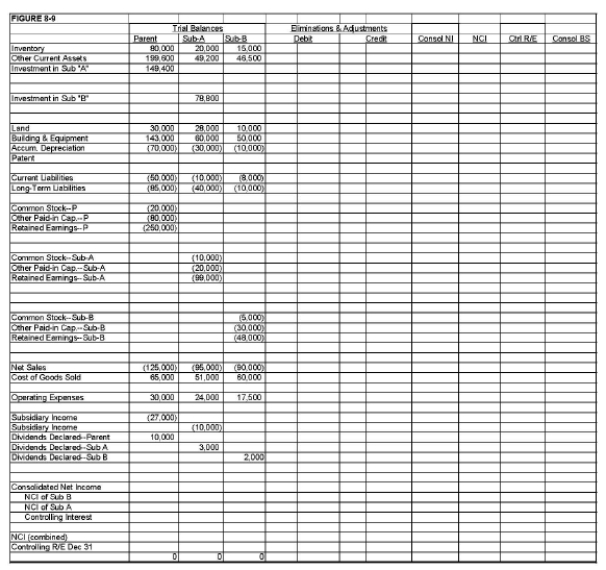On January 1, 20X1, Parent Company purchased 90% of the common stock of Sub-A Company for $90,000. On this date, Sub-A had common stock, other paid-in capital, and retained earnings of $10,000, $20,000, and $60,000 respectively.
On January 1, 20X2, Sub-A Company purchased 80% of the common stock of Sub-B Company for $64,000. On this date, Sub-B Company had common stock, other paid-in capital, and retained earnings of $5,000, $30,000, and $40,000 respectively.
Any excess of cost over book value on either purchase is due to a patent, to be amortized over ten years.
Both Parent and Sub-A have accounted for their investments using the simple equity method.
During 20X2, Sub-B sold merchandise to Sub-A for $20,000, of which one-fourth is still held by Sub-B on December 31, 20X2. Sub-B's usual gross profit is 40%. During 20X3, Sub-B sold more goods to Sub-A for $30,000, of which $10,000 is still on hand on December 31, 20X3.
Required:
Complete the Figure 8-9 worksheet for consolidated financial statements for 20X3. 
Correct Answer:
Verified
View Answer
Unlock this answer now
Get Access to more Verified Answers free of charge
Q21: Company P had 300,000 shares of common
Q23: A owns 80% of B and 20%
Q24: On January 1, 20X1, Prism Company purchased
Q25: On January 1, 20X1, Parent Company purchased
Q27: On January 1, 20X1, Parent Company purchased
Q28: When a subsidiary owns shares of the
Q29: On January 1, 20X1, Parent Company purchased
Q30: On January 1, 20X1, Parent Company purchased
Q32: On 1/1/X1 Poncho acquired an 80% interest
Q33: Plum Inc. acquired 90% of the capital
Unlock this Answer For Free Now!
View this answer and more for free by performing one of the following actions

Scan the QR code to install the App and get 2 free unlocks

Unlock quizzes for free by uploading documents